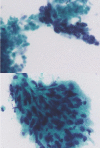Oral squamous cell cancer: early detection and the role of alcohol and smoking
- PMID: 21211041
- PMCID: PMC3022893
- DOI: 10.1186/1758-3284-3-2
Oral squamous cell cancer: early detection and the role of alcohol and smoking
Abstract
Objective: Oral squamous cell carcinoma has a remarkable incidence worldwide and a fairly onerous prognosis, encouraging further research on factors that might modify disease outcome.
Data sources: A web-based search for all types of articles published was initiated using Medline/Pub Med, with the key words such as oral cancer, alcohol consumption, genetic polymorphisms, tobacco smoking and prevention. The search was restricted to articles published in English, with no publication date restriction (last update 2010).
Review methods: In this review article, we approach the factors for a cytologic diagnosis during OSCC development and the markers used in modern diagnostic technologies as well. We also reviewed available studies of the combined effects of alcohol drinking and genetic polymorphisms on alcohol-related cancer risk.
Results: The interaction of smoking and alcohol significantly increases the risk for aero-digestive cancers. The interaction between smoking and alcohol consumption seems to be responsible for a significant amount of disease.
Conclusion: Published scientific data show promising pathways for the future development of more effective prognosis. There is a clear need for new prognostic indicators, which could be used in diagnostics and, therefore a better selection of the most effective treatment can be achieved.
Figures


References
-
- Llewellyn CD, Linklater K, Bell J, Johnson NW, Warnakulasuriya KA. Squamous cell carcinoma of the oral cavity in patients aged 45 years and under: a descriptive analysis of 116 cases diagnosed in the South East of England from 1990 to 1997. Oral Oncol. 2003;39(2):106–114. doi: 10.1016/S1368-8375(02)00026-X. - DOI - PubMed
Publication types
MeSH terms
LinkOut - more resources
Full Text Sources
Medical

